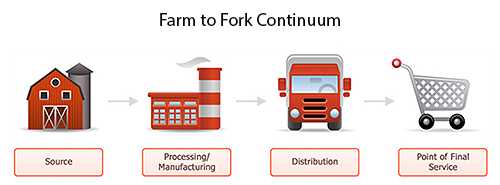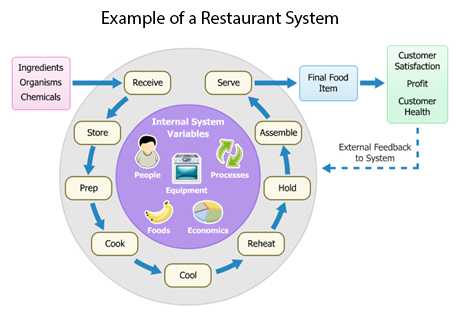System Theory
EHS-Net work is based on system theory. System theory is “a general science of wholeness”: rather than dissecting a complex process and studying the individual parts, system theory focuses on understanding the complete system and the underlying interactions of all the forces that make up that system.
Systems are usually made up of four major elements:
- Input (the energy or material that goes into the system)
- Processes (the actions that happen within the system that transforms the input)
- Output (what results from the processes)
- Feedback (the information that is produced that can be used to evaluate and monitor the system)
In system theory, it is important to remember the whole is more than the sum or its parts. Dynamic interactions among the parts can often result in characteristics of the whole that are not the same as the characteristics of the separate parts. Change in one part of the system may affect the other parts or the whole.
Food Safety and the Environment
The path from food source to the point of final service is called the farm to fork continuum.

The source is where the food item originates. This could be a farm where produce is grown, a sea from which fish are harvested, a dairy farm or beef cattle operation, and so on. It could also be freshwater aquaculture.
Processing/manufacturing includes all the steps along the food chain that prepare a food item for distribution. In the case of produce, this encompasses everything from washing produce and preparing it for sale, to pasteurization or low acidity canning.
Distribution includes everything from storage and warehousing, repacking, reprocessing, and transport to the next point in the continuum. Sometimes distribution involves multiple points.
Point of final service includes every place where food is purchased and/or consumed, from delis, cafeterias, restaurants, grocery stores, and so on, to the home.
Point of Final Service (Food Establishment System)
Each point along the farm to fork continuum represents its own unique system. A restaurant is an example of a system.

The outcome of the system (food served to customers) is influenced by inputs (such as ingredients, organisms, chemicals) and processes (such as storing, preparing, cooking, and serving) that make up the system. Internal system variables such as food workers, equipment, and the economics also influence the outcome.
EHS-Net uses system theory to identify environmental antecedents (underlying factors) to illness and disease outbreaks.
Publications Related to System Theory
Read about how the systems approach has been used to investigate foodborne and waterborne outbreaks:
- Dippold L, Lee R, Selman C, Monroe S, Henry C. A gastroenteritis outbreak due to norovirus associated with a Colorado hotel. J Environ Health. 2003;66(3):13-7
- Gelting R, Sarisky J, Selman C, Otto C, Higgins C, Bohan PO, Buchanan SB, Meehan PJ. Use of a systems-based approach to an environmental health assessment for a waterborne disease outbreak investigation at a snowmobile lodge in Wyoming. Int J Hyg Environ Health. 2005;208(1–2):67–73.
- Higgins CL, Hartfield, BS. A systems-based food safety evaluation: an experimental approach [PDF – 408 KB]. J Environ Health. 2004;67(4) 9–14.
- Selman CA, Guzewich JJ. Public health measures: environmental assessment in outbreak investigations. [PDF – 732 KB] In: Motariemi Y, editor. Encyclopedia of food safety. 1st ed. Waltham, MA: Academic Press; 2014. p. 98-106.
- Page last reviewed: August 4, 2017
- Page last updated: August 4, 2017
- Content source:


 ShareCompartir
ShareCompartir